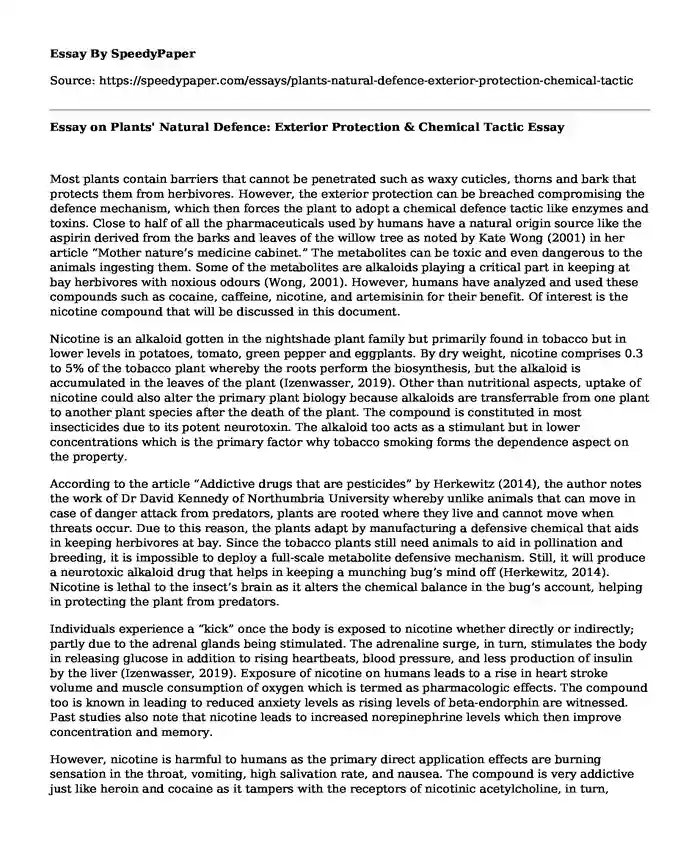Most plants contain barriers that cannot be penetrated such as waxy cuticles, thorns and bark that protects them from herbivores. However, the exterior protection can be breached compromising the defence mechanism, which then forces the plant to adopt a chemical defence tactic like enzymes and toxins. Close to half of all the pharmaceuticals used by humans have a natural origin source like the aspirin derived from the barks and leaves of the willow tree as noted by Kate Wong (2001) in her article “Mother nature’s medicine cabinet.” The metabolites can be toxic and even dangerous to the animals ingesting them. Some of the metabolites are alkaloids playing a critical part in keeping at bay herbivores with noxious odours (Wong, 2001). However, humans have analyzed and used these compounds such as cocaine, caffeine, nicotine, and artemisinin for their benefit. Of interest is the nicotine compound that will be discussed in this document.
Nicotine is an alkaloid gotten in the nightshade plant family but primarily found in tobacco but in lower levels in potatoes, tomato, green pepper and eggplants. By dry weight, nicotine comprises 0.3 to 5% of the tobacco plant whereby the roots perform the biosynthesis, but the alkaloid is accumulated in the leaves of the plant (Izenwasser, 2019). Other than nutritional aspects, uptake of nicotine could also alter the primary plant biology because alkaloids are transferrable from one plant to another plant species after the death of the plant. The compound is constituted in most insecticides due to its potent neurotoxin. The alkaloid too acts as a stimulant but in lower concentrations which is the primary factor why tobacco smoking forms the dependence aspect on the property.
According to the article “Addictive drugs that are pesticides” by Herkewitz (2014), the author notes the work of Dr David Kennedy of Northumbria University whereby unlike animals that can move in case of danger attack from predators, plants are rooted where they live and cannot move when threats occur. Due to this reason, the plants adapt by manufacturing a defensive chemical that aids in keeping herbivores at bay. Since the tobacco plants still need animals to aid in pollination and breeding, it is impossible to deploy a full-scale metabolite defensive mechanism. Still, it will produce a neurotoxic alkaloid drug that helps in keeping a munching bug’s mind off (Herkewitz, 2014). Nicotine is lethal to the insect’s brain as it alters the chemical balance in the bug’s account, helping in protecting the plant from predators.
Individuals experience a “kick” once the body is exposed to nicotine whether directly or indirectly; partly due to the adrenal glands being stimulated. The adrenaline surge, in turn, stimulates the body in releasing glucose in addition to rising heartbeats, blood pressure, and less production of insulin by the liver (Izenwasser, 2019). Exposure of nicotine on humans leads to a rise in heart stroke volume and muscle consumption of oxygen which is termed as pharmacologic effects. The compound too is known in leading to reduced anxiety levels as rising levels of beta-endorphin are witnessed. Past studies also note that nicotine leads to increased norepinephrine levels which then improve concentration and memory.
However, nicotine is harmful to humans as the primary direct application effects are burning sensation in the throat, vomiting, high salivation rate, and nausea. The compound is very addictive just like heroin and cocaine as it tampers with the receptors of nicotinic acetylcholine, in turn, stimulating the dopaminergic transmission, thus elevating moods (Izenwasser, 2019). Nicotine is dangerous for several reasons; it encourages nAChRs which initiates and propels cancer via increased cell proliferation; the compound leads to lung and gastrointestinal carcinogenesis as it has been witnessed that individuals who smoke have lower and toxic efficacy of chemotherapeutic drugs; leads to breast and pancreatic cancer as it stimulates pancreatic adenocarcinoma translating to a growth of nonsmall cell pancreatic and lung cancer. In overall, the compound is helpful to the plants and humans too but very harmful to humans when taken as a stimulant.
References
Izenwasser, S. (2019). Nicotine Effects in Adolescents. Neuroscience of Nicotine, 17–23. https://doi.org/10.1016/b978-0-12-813035-3.00003-4
Herkewitz, W. (2014, March 5). Addictive Drugs That Are Actually Pesticides. https://www.mentalfloss.com/article/55372/addictive-drugs-are-actually-pesticides.
Wong, K. (2001, April 9). Mother Nature's Medicine Cabinet. Scientific American. https://www.scientificamerican.com/article/mother-natures-medicine-c/.
Cite this page
Essay on Plants' Natural Defence: Exterior Protection & Chemical Tactic. (2023, Nov 14). Retrieved from https://speedypaper.net/essays/plants-natural-defence-exterior-protection-chemical-tactic
Request Removal
If you are the original author of this essay and no longer wish to have it published on the SpeedyPaper website, please click below to request its removal:
- Free Essay Sample about Democratization of Germany
- Essay Example on Dopamine in Addictions
- Free Essay Sample about California Wildfires 2007
- Gender and Biology Essay Sample
- The Power of Young Activists: Essay Sample on the Republican Revolution
- Essay Example - Hazardous Waste Operations and Emergency Response
- Essay Example. Basic Types of Rocks and the Rock Cycle
Popular categories





